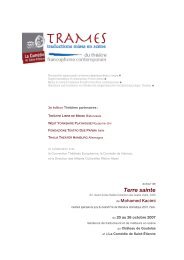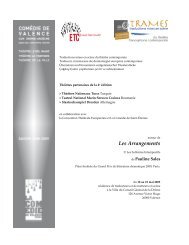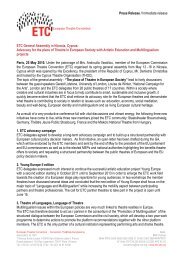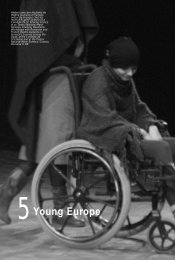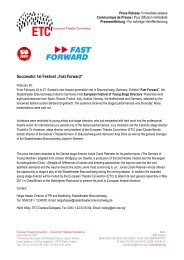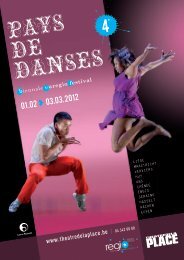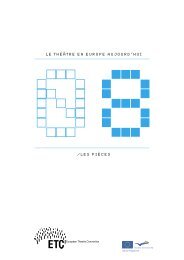Le théâtre en Europe aujourd'hui - European Theatre Convention
Le théâtre en Europe aujourd'hui - European Theatre Convention
Le théâtre en Europe aujourd'hui - European Theatre Convention
You also want an ePaper? Increase the reach of your titles
YUMPU automatically turns print PDFs into web optimized ePapers that Google loves.
ADDRESS/ADRESSE<br />
Marjana Šket (Ag<strong>en</strong>t)<br />
Copyright Ag<strong>en</strong>cy of Slov<strong>en</strong>ia<br />
Slov<strong>en</strong>ska cesta 47<br />
1000 Ljubljana<br />
T: + 386 1 300 15 60<br />
E: marjana.sket@aas.si<br />
><br />
WORKS/ŒUVRES<br />
Kostanjeva krona; Nimfa umre;<br />
Zakaj imajo sloni velika ušesa; Kaj<br />
pa <strong>Le</strong>onardo?; Jutri bo lepše<br />
PREMIERE/CRÉATION<br />
Prešernovo gledališce Kranj<br />
24.05.06<br />
DIRECTOR/METTEUR EN SCÈNE<br />
Dušan Mlakar<br />
ADDRESS/ADRESSE<br />
AGRFT (Academy of <strong>Theatre</strong>, Radio,<br />
Film and Television)<br />
Nazorjeva 3<br />
1000 Ljubljana<br />
E: agrft-gledalisce@uni-lj.si<br />
PUBLISHER/EDITEUR<br />
Sodobnost International / Vodnikova<br />
založba (DSKG)<br />
Suhadolicanova 64a<br />
1000 Ljubljana<br />
TRANSLATIONS/TRADUCTIONS<br />
English/Anglais, German/Allemand,<br />
Czech/Tchèque, Slovak/Slovaque,<br />
Arabic/Arabe<br />
AWARDS/PRIX<br />
Slavko Gruma Award for Best<br />
Slov<strong>en</strong>ian Play/Prix « Slavko<br />
Gruma » pour la meilleure pièce<br />
(2004)<br />
CHARACTERS/PERSONNAGES<br />
2 male/hommes<br />
2 female/femmes<br />
Evald Flisar 1945<br />
nora nora<br />
crazy nora<br />
nora la folle<br />
Evald Flisar, novelist and author of many travel diaries and plays,<br />
such as What About <strong>Le</strong>onardo? (Grum’s Award for best play of the<br />
year), Tomorrow Will Be Better (Prešer<strong>en</strong> Fund Award) and Crazy<br />
Nora (Grum’s Award for best play of the year), has be<strong>en</strong> produced<br />
in Slov<strong>en</strong>ia and eighte<strong>en</strong> other countries, including England and<br />
Egypt. He is a highly imaginative writer whose plays are at once<br />
clever, grotesque and sombre. Crazy Nora, like the early Elfride<br />
Jelinek play What Happ<strong>en</strong>ed After Nora <strong>Le</strong>ft Her Husband or Pillars<br />
of Society, refer<strong>en</strong>ces Ibs<strong>en</strong>’s A Doll’s House in the name of the title<br />
character and more. But Ibs<strong>en</strong> is only the very beginning—the use<br />
of his character in fact serves a point of departure for a dialogue<br />
betwe<strong>en</strong> authors that interweaves the past with the pres<strong>en</strong>t. Like<br />
Jelinek and Ibs<strong>en</strong>, Flisar is interested in the ‘war of the sexes’.<br />
According to him, Ibs<strong>en</strong>’s character is in some way pres<strong>en</strong>t in<br />
almost every modern play that deals with male/female (in)equality.<br />
Nora has become a kind of a paradigmatic figure of the weak<strong>en</strong>ed<br />
female subject who does not want to accept the commodification of<br />
g<strong>en</strong>der relationships required by contemporary globalized society.<br />
In Crazy Nora we find four characters: two pairs, Nora 1, Nora<br />
2, Halmer 1 and Halmer 2, and all the combinations they can<br />
produce—all the stories, all the twists and turns, all the tones of<br />
voice and modes of communication that four people can give rise to.<br />
Evald Flisar, auteur de romans, de nombreux de récits de voyages<br />
et de pièces de <strong>théâtre</strong> est un écrivain d’une grande imagination<br />
dont les pièces ludiques sont <strong>en</strong> même temps intellig<strong>en</strong>tes,<br />
grotesques et sombres. Sa Nora la folle se réfère comme la pièce<br />
d’Elfriede Jelinek à la Maison de Poupée d’Ibs<strong>en</strong>. Mais l’utilisation<br />
du personnage de Nora ne sert que comme point de départ pour un<br />
dialogue <strong>en</strong>tre auteurs qui <strong>en</strong>trelace le passé et le prés<strong>en</strong>t. Comme<br />
Jelinek et Ibs<strong>en</strong>, Flisar s’intéresse à la « guerre des sexes ».<br />
Selon lui, le personnage d’Ibs<strong>en</strong> est, d’une manière ou d’une<br />
autre, prés<strong>en</strong>t dans presque chaque pièce moderne qui traite de<br />
l’(in)égalité <strong>en</strong>tre hommes et femmes. Nora est dev<strong>en</strong>ue une sorte<br />
de figure paradigmatique du sujet féminin affaibli qui ne veut pas<br />
accepter la marchandisation des relations <strong>en</strong>tre les sexes telle que<br />
la société mondialisée d’aujourd’hui l’exige. Dans Nora la Folle, il<br />
y a quatre personnages : deux couples, Nora 1, Nora 2, Halmer 1<br />
et Halmer 2 – et toutes les combinaisons qui peuv<strong>en</strong>t <strong>en</strong> résulter,<br />
toutes les histoires, tous les tons de voix et tous les modes de<br />
communication que quatre personnes peuv<strong>en</strong>t <strong>en</strong>g<strong>en</strong>drer.<br />
slov<strong>en</strong>ia<br />
> slov<strong>en</strong>ija<br />
slovénie<br />
+ info<br />
> www.etc-cte.org<br />
141




